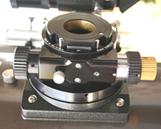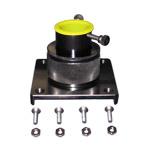Focuser Upgrades
Jack Kramer
It's hard not to be tantalized by the smooth action of Crayford design focusers, and thus inspired, many people are replacing their standard rack-and-pinion focusers. This became more common with the introduction of the Chinese-made Dobsonians, the earlier versions of which were equipped with rather crude R&P focusers that had rough movement and so much slop that an eyepiece could wiggle back and forth. Of course, this also made it difficult to do a really accurate collimation. The Chinese and Taiwanese telescope makers have greatly improved their R&P focusers since then, but because so many observers favor the silky smoothness of a Crayford, scopes from the Far East are now frequently coming with a Crayford as standard equipment.
It seems that all Chinese-made rack-and-pinion focusers still have a common, but easily corrected malady - the mechanisms are packed with grease that is so thick that it's more like soft glue. When I received my Orion XT Dob, I found there was a "crackling" sound when racking the focuser in and out. It was the so-called grease. The focuser is easily disassembled and the original grease removed with an old toothbrush and mineral spirits. I replaced it with dielectric tune-up grease available at auto parts stores. After adjusting the tension, I have a smoothly operating R&P focuser.
 There are very nice single and multi-speed Crayford focusers now on the market. Some have motor drives for absolutely vibration-proof focusing. They also have a variety of base plates available so that in many cases no re-drilling of your telescope tube is necessary. Some top made-in-the-U.S. brands include MoonLite, Feather Touch, JMI. Crayford focusers from the Far East are also available separately as drop-in replacement units from suppliers such as Orion and Scopestuff; they're less expensive but reports indicate the fit and finish isn't quite up to the standards of the domestic makes.
There are very nice single and multi-speed Crayford focusers now on the market. Some have motor drives for absolutely vibration-proof focusing. They also have a variety of base plates available so that in many cases no re-drilling of your telescope tube is necessary. Some top made-in-the-U.S. brands include MoonLite, Feather Touch, JMI. Crayford focusers from the Far East are also available separately as drop-in replacement units from suppliers such as Orion and Scopestuff; they're less expensive but reports indicate the fit and finish isn't quite up to the standards of the domestic makes.
For many years, those who craved the absolute smoothest and most precise focuser action would opt for a low-profile helical focuser, but because you rotate the drawtube to focus, it takes a long time to go from one end of the focus range to the other. Many observers found these frustrating to use. A few suppliers, such as Lumicon still sell this type of focuser.
 Orion is one of the few places that carry low-cost rack-and-pinion focusers, but if you do a search of suppliers, you're not likely to find any high-end R&P focusers. While it seems that all the "best" focusers are Crayfords, that's sort of a fallacy. It's actually easier to make a Crayford focuser than a rack & pinion. With a Crayford, rollers bearing against the drawtube are what guide the in-and-out motion. With an R&P, you need a well-machined pinion gear and a toothed rack cut on a bias. This helps explain why the earlier Chinese and Taiwanese R&P focusers weren't very smooth - it takes some effort to make a good one. Moreover, back in the 1980's, a problem with early Crayfords was that they didn't have much lifting power. Add a heavy eyepiece or camera on your focuser and the drawtube would sometimes slip back down. Today's improved designs have eliminated that situation. The Crayford focuser on my Vixen refractor operates very smoothly and easily handles the heaviest eyepieces. However, many of the highest-quality telescopes still include finely engineered R&P focusers, which have a silky smooth motion, maintain exact alignment, and can accommodate more weight than a Crayford. Often the drawtubes are around four inches in diameter so as to be able to use any size imaging equipment, plus that larger drawtube helps make the motion extremely smooth.
Orion is one of the few places that carry low-cost rack-and-pinion focusers, but if you do a search of suppliers, you're not likely to find any high-end R&P focusers. While it seems that all the "best" focusers are Crayfords, that's sort of a fallacy. It's actually easier to make a Crayford focuser than a rack & pinion. With a Crayford, rollers bearing against the drawtube are what guide the in-and-out motion. With an R&P, you need a well-machined pinion gear and a toothed rack cut on a bias. This helps explain why the earlier Chinese and Taiwanese R&P focusers weren't very smooth - it takes some effort to make a good one. Moreover, back in the 1980's, a problem with early Crayfords was that they didn't have much lifting power. Add a heavy eyepiece or camera on your focuser and the drawtube would sometimes slip back down. Today's improved designs have eliminated that situation. The Crayford focuser on my Vixen refractor operates very smoothly and easily handles the heaviest eyepieces. However, many of the highest-quality telescopes still include finely engineered R&P focusers, which have a silky smooth motion, maintain exact alignment, and can accommodate more weight than a Crayford. Often the drawtubes are around four inches in diameter so as to be able to use any size imaging equipment, plus that larger drawtube helps make the motion extremely smooth.
A motorized focuser provides the finest control, since you aren't touching the telescope, which induces some tremors while trying to focus. This is especially useful when doing astrophotography. For this purpose I use a JMI NGF-S unit - a motorized Crayford that interfaces between the existing visual back and the star diagonal. Since it adds about 2" to the tailpiece, it works only with refractors and SCTs. (However, the NGF-S is no longer listed on the JMI web site.)
So if you have some issues with your present focuser, see whether you can tune it up. If it doesn't hold your eyepieces securely enough, you might want to try a 11/4" adapter with a compression ring inner sleeve. The best focusers include a compression ring that grips the eyepiece more securely without marring the surface of the barrel. If your old focuser still doesn't have the nice smooth motion you want or has too much drawtube slop, then there are a lot of good replacement units.
Published in the September 2008 issue of the NightTimes




